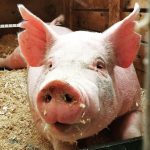 As far as most people are concerned, pig, hog, boar, sow, and swine are different words for the same porky animal; however, to those versed in the niceties of the sty, hog denotes a castrated pig, boar denotes an uncastrated pig, sow denotes a female pig, and swine denotes any piglike creature, whether wild or domesticated, castrated or uncastrated, married or divorced. Of these five words, swine and sow are the oldest, first recorded in the early eighth century. The fact that these two words appeared at the same time is perhaps not surprising, given that they derive from a single Indo-European source (the word hyena also derives, through Greek, from the same Indo-European source as swine and sow, the Greeks having considered the hyena the “swine” of the dog family). Boar is first recorded in English in the eleventh century, although it must have been in use earlier as the male counterpart for the much older sow. The word hog, which is not recorded until the fourteenth century, must also have been in use much earlier because a word derived from it—hoggaster, a three-year-old hog—is recorded in the twelfth century. Interestingly, it is possible that the word hog did not originally refer to pigs, nor to any particular species of animal; instead, hog may have been applied to any domesticated animal of a certain young age: even today, and dating back to the fourteenth century, hog is used in England and Scotland as the name for a one-year-old sheep. If hog did indeed arise as a term indicating age, then the word may have derived from the Old English hag, meaning to hack, a graphic reference to the castration hogs underwent in their first year.
As far as most people are concerned, pig, hog, boar, sow, and swine are different words for the same porky animal; however, to those versed in the niceties of the sty, hog denotes a castrated pig, boar denotes an uncastrated pig, sow denotes a female pig, and swine denotes any piglike creature, whether wild or domesticated, castrated or uncastrated, married or divorced. Of these five words, swine and sow are the oldest, first recorded in the early eighth century. The fact that these two words appeared at the same time is perhaps not surprising, given that they derive from a single Indo-European source (the word hyena also derives, through Greek, from the same Indo-European source as swine and sow, the Greeks having considered the hyena the “swine” of the dog family). Boar is first recorded in English in the eleventh century, although it must have been in use earlier as the male counterpart for the much older sow. The word hog, which is not recorded until the fourteenth century, must also have been in use much earlier because a word derived from it—hoggaster, a three-year-old hog—is recorded in the twelfth century. Interestingly, it is possible that the word hog did not originally refer to pigs, nor to any particular species of animal; instead, hog may have been applied to any domesticated animal of a certain young age: even today, and dating back to the fourteenth century, hog is used in England and Scotland as the name for a one-year-old sheep. If hog did indeed arise as a term indicating age, then the word may have derived from the Old English hag, meaning to hack, a graphic reference to the castration hogs underwent in their first year.
A strongly fortified container, typically constructed of lead, utilized for the secure storage of radioisotopes and radioactive materials.
